
|
JUDEA PEARL |
The Art and Science of Cause and Effect |
Given Thursday, October 29, 1996 as part of the
UCLA 81st Faculty Research Lecture Series
|
UCLA Computer Science Department
4532 Boelter Hall
tel: (310) 825-3243
fax: (310) 825-2273 |
| email to:judea@cs.ucla.edu |
BELOW IS A TRANSCRIPT OF THE LECTURE:

|
SLIDE 1: THE ART AND SCIENCE OF CAUSE AND EFFECT
OPENING STATEMENT
Thank you Chancellor Young, colleagues, and members of
the Senate Selection Committee for inviting me to deliver
the eighty-first lecture in the UCLA Faculty Research
Lectureship Program.
It is a great honor to be deemed worthy of this
podium, and to be given the opportunity to share my research
with such a diverse and distinguished audience.
The topic of this lecture is causality --
namely, our awareness of what causes what in the world
and why it matters.
Though it is basic to human thought, Causality is
a notion shrouded in mystery, controversy, and caution,
because scientists and philosophers have had difficulties
defining when one event TRULY CAUSES another.
We all understand that the rooster's crow does
not cause the sun to rise, but even this simple fact
cannot easily be translated into a mathematical equation.
|
Today, I would like to share with you a set of ideas which I
have found very useful in studying phenomena of this kind.
These ideas have led to practical tools that I hope
you will find useful on your next encounter
with a cause and effect.
And it is hard to imagine anyone here who is NOT dealing
with cause and effect.
Whether you are evaluating the impact
of bilingual education programs or running an experiment on
how mice distinguish food from danger
or speculating about why Julius Caesar crossed the Rubicon or
diagnosing a patient
or predicting who will win the 1996 presidential
election, you are dealing with a tangled web of cause-effect considerations.
The story that I am about to tell is aimed at helping
researchers deal with the complexities
of such considerations, and to clarify their meaning.

|
SLIDE 2: OUTLINE
This lecture is divided into three parts.
I begin with a brief
historical sketch of the difficulties that various disciplines
have had with causation.
Next I outline the ideas
that reduce or eliminate several of these historical
difficulties.
Finally, in honor of my
engineering background, I will show how
these ideas lead to simple practical tools,
which will be demonstrated in the areas of
statistics and social science.
|
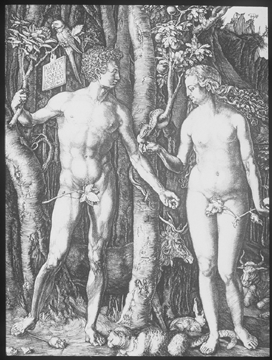
|
SLIDE 3: ADAM AND EVE (DURER)
In the beginning, as far as we can tell,
causality was not problematic.
The urge to ask WHY and the
capacity to find causal
explanations came very early in human development.
The bible, for example, tells us that
just a few hours after tasting from the tree of knowledge,
Adam is already an expert in causal arguments.
When God asks: "Did you eat from that tree?"
This is what Adam replies:
"The woman whom you gave to be with me,
She handed me the fruit from the tree;
and I ate."
Eve is just as skillful:
"The serpent deceived me, and I ate."
|
The thing to notice about this story is
that God did not ask for explanation, only for the facts:
It was Adam who felt the need to explain -- the message is clear,
causal explanation is a man-made concept.
Another interesting point about the story: explanations
are used exclusively for passing responsibilities.
Indeed, for thousands of years explanations had no other
function. Therefore, only Gods, people
and animals could cause things to happen, not objects,
events or physical processes.
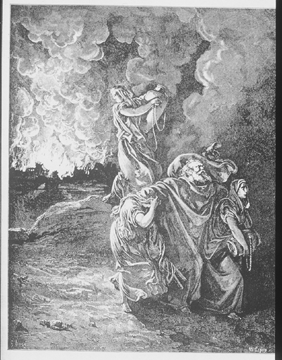
|
SLIDE 4: THE FLIGHT OF LOT (DORE)
Natural events entered into causal explanations
much later, because, in the ancient world, events
were simply PREDETERMINED.
Storms and earthquakes were CONTROLLED by the angry gods,
and could not, in themselves, assume causal
responsibility for the consequences.
|
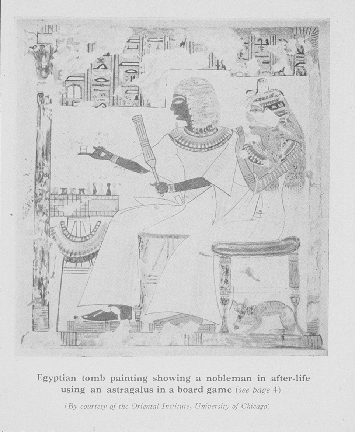
|
SLIDE 5: BOARD GAME (EGYPTIAN TOMB)
Even an erratic and unpredictable event such as the
roll of a die was not considered CHANCE event but
rather a divine message demanding proper interpretation.
|
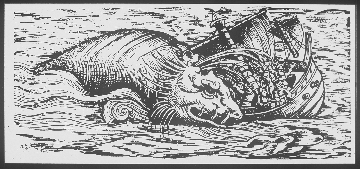
|
SLIDE 6: ON BOATS AND WHALES
One such message gave the prophet Jonah the scare of his life
when he was identified as God's renegade and was thrown OVERBOARD.
Quoting from the book of Jonah:
"And the sailors said: `Come and let us cast lots to find out
who is to blame for this ordeal.' So they cast lots and the lot fell on Jonah."
Obviously, on this luxury Phoenician cruiser, "casting Lots" were
not used for recreation, but for communication -- a one-way
modem for processing messages of vital importance.
In summary, the agents of causal forces
in the ancient world were either deities, who cause things
to happen for a purpose, or human beings and animals,
who possess free will, for which they
are punished and rewarded.
|
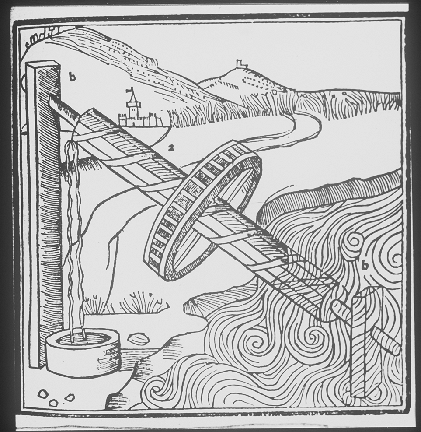
|
SLIDE 7: ARCHIMEDES' SCREW PUMP (VITRUVIUS, 1511)
This notion of causation was naive, but clear and unproblematic.
The problems began, as usual, with engineering; when machines
had to be constructed to do useful jobs.
|
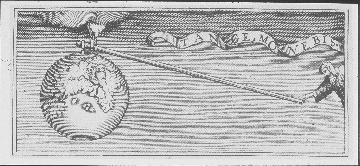
|
SLIDE 8: "... AND I WILL MOVE THE EARTH" (VAVIGNON, 1687)
As engineers grew ambitious, they decided that the
earth, too, can be moved, but not with a single lever.
|
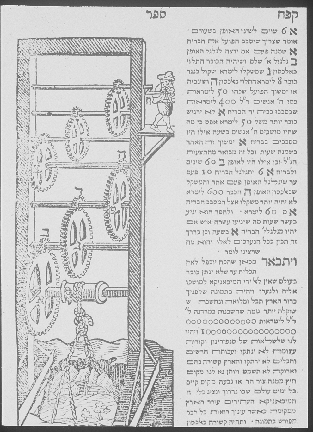
|
SLIDE 9: EARTH MOVING MACHINE (DELMEDIGO, 1629)
Systems consisting of many
pulleys and wheels, one driving another, were needed
for projects of such magnitude.
And, once people started building multi-stage systems,
an interesting thing happened to causality -- PHYSICAL
OBJECTS BEGAN ACQUIRING CAUSAL CHARACTER\.
When a system like that broke down, it was futile
to blame God or the operator -- instead,
a broken rope or a rusty pulley were more
useful explanations, simply because those
could be replaced easily, and make the system work.
At that point in history, Gods and humans
ceased to be the sole agents of causal
forces -- lifeless objects and processes
became partners in responsibility.
A wheel turned and stopped BECAUSE the wheel
proceeding it turned
and stopped -- the human operator became secondary.
|
Not surprisingly, these new agents of causation TOOK ON
some of the characteristics of their predecessors --
Gods and humans.
Natural objects became not only
carriers of credit and blame, but also carriers of
force, will, and even purpose.
Aristotle regarded explanation in terms of a PURPOSE
to be the only complete and satisfactory explanation for why a
thing is what it is. He even called it a "FINAL CAUSE",
namely, the final aim of scientific inquiry.
From that point on, causality served a dual role:
CAUSES were the targets of credit and blame on one
hand, and the carriers of physical flow of control on the other.
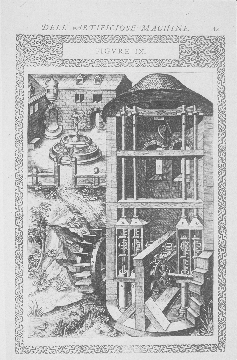
|
SLIDE 10: WATER-MILL
This duality survived in relative tranquility until
about the time of the Renaissance, when it encountered
conceptual difficulties.
|

|
SLIDE 11: THE CASTLE OF KNOWLEDGE (RECORDES, 1575)
What happened can be seen on the title page of Recordes' book "The
Castle of Knowledge," the first science book in English,
published in 1575.
The wheel of fortune is turned, not by the wisdom of
God, but by the ignorance of man.
And, as the role of God, the final cause, was taken
over by human knowledge, the whole notion of causal explanation
came under attack.
|
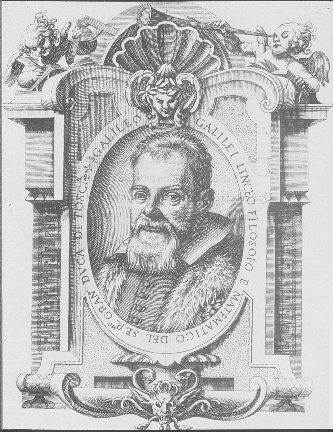
|
SLIDE 12: GALILEO (PORTRAIT, 1613)
The erosion started with the work of Galileo.
|
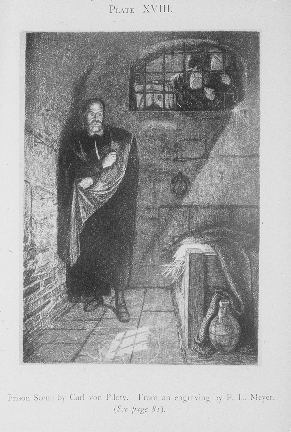
|
SLIDE 13: GALILEO (PRISON SCENE)
Most of us know Galileo as the man who was brought before
by the inquisition and imprisoned
for defending the heliocentric theory of the world.
But while all that was going on,
Galileo also managed to quietly engineer the most profound
revolution that science has ever known.
|
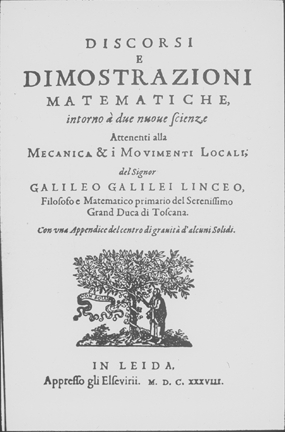
|
SLIDE 14: TITLE PAGE OF DISCORSI
This revolution,
expounded in his 1638 book "Discorsi" published in Leyden, far
from Rome, consists of two
Maxims:
|
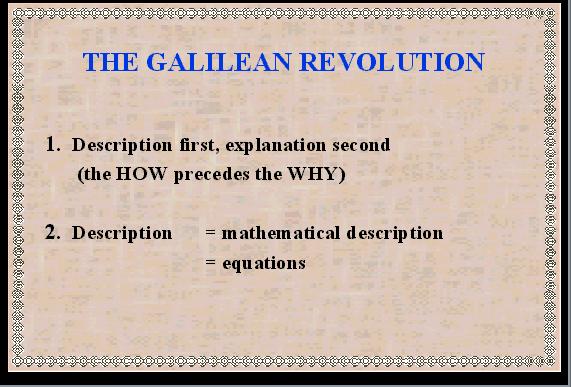
|
SLIDE 15: THE GALILEAN REVOLUTION
ONE, description first, explanation second--that is, the how precedes
the why; and
TWO, description is carried out in the language
of mathematics; namely, equations.
Ask not, said Galileo, whether an object falls
because it is pulled from below
or pushed from above.
|
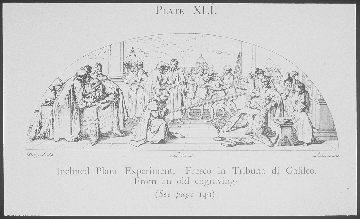
|
SLIDE 16: INCLINED PLAIN EXPERIMENT
Ask how well you can predict the time
it takes for the object to travel a certain distance,
and how that time will vary from object to object,
and as the angle of the track changes.
Moreover, said Galileo, do not attempt to answer such
questions in the qualitative and
slippery nuances of human language; say it
in the form of mathematical equations.
|
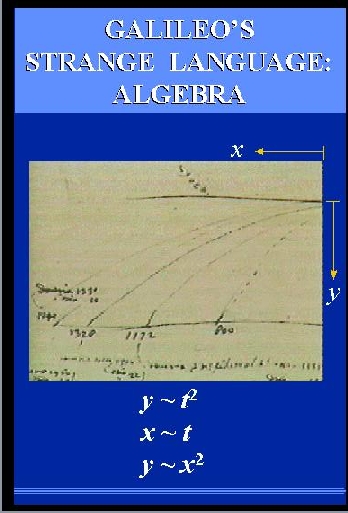
|
SLIDE 17: GALILEAN EQUATION d=t2
It is hard for us to appreciate today how strange that idea
sounded in 1638, barely 50 years after the introduction
of algebraic notation by Vieta.
To proclaim algebra the UNIVERSAL language of
science, would sound today like proclaiming Esperanto the language of economics.
Why would Nature agree to speak Algebra? of all languages?
But you can't argue with success.
The distance traveled by an object turned out
indeed to be proportional to the square of the
time.
|
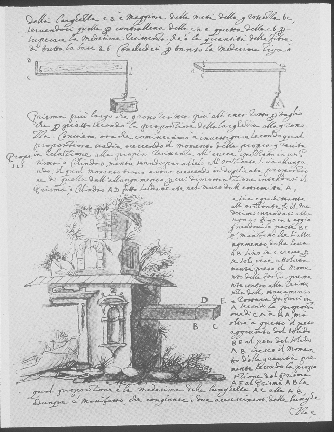
|
SLIDE 18: GALILEAN BEAMS (MANUSCRIPT, Discorsi, 1638)
Even more successful than predicting outcomes of experiments
were the computational aspects of algebraic equations.
They enabled engineers, for the first time in history,
to ask "how to" questions, in addition to "what if"
questions.
In addition to asking:
"What if we narrow the beam, will it carry the load?"
They began to ask more difficult questions:
"How to shape the beam so that it WILL carry the load?"
This was made possible by the availability
of methods for solving equations.
The algebraic machinery does not discriminate among variables;
instead of predicting behavior in terms of parameters, we can
turn things around and solve for
the parameters, in terms of the desired behavior.
Let us concentrate now
on Galileo's first maxim, "description first explanation second",
because that idea was taken very seriously
by the scientists, and changed the character of
science from speculative to empirical.
|
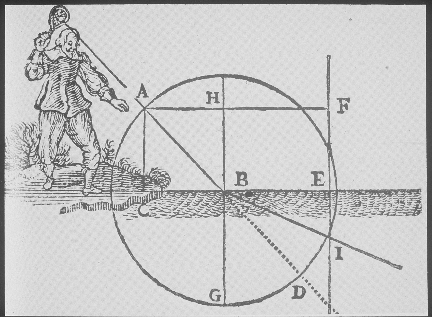
|
SLIDE 19: SNELL'S LAW (FROM DESCARTE'S DIOPTRICS, 1637)
Physics became flooded with empirical laws that were
extremely useful.
Snell law, Hookes law, Ohm's law, and Joule's law are
examples of purely empirical generalizations that were discovered and used
much before they were explained by more fundamental principles.
|

|
SLIDE 20: HOOKE'S LAW (1678)
Philosophers, however, were reluctant to give up the idea
of causal explanation, and continued to search for the origin and justification
of those successful Galilean equations.
For example, Descartes ascribed cause to ETERNAL
TRUTH.
Liebnitz made cause a SELF-EVIDENT LOGICAL LAW.
|
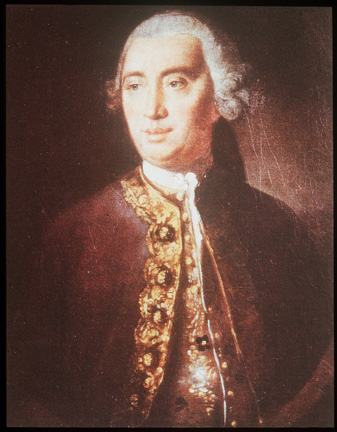
|
SLIDE 21: ALEXANDER HUME (PORTRAIT)
Finally, about one hundred years after Galileo,
a Scottish philosopher by the name of David Hume
carried Galileo's first maxim to an extreme.
|
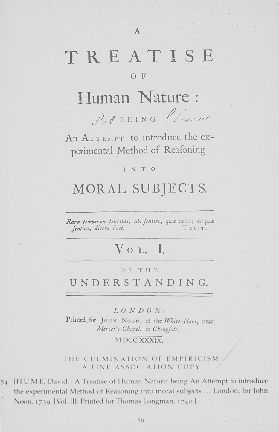
|
SLIDE 22: TITLE PAGE OF HUME - "A TREATISE OF HUMAN NATURE"
Hume argued convincingly
that the WHY is not merely
second to the HOW, but that the WHY is totally superfluous as
it is subsumed by the HOW.
|
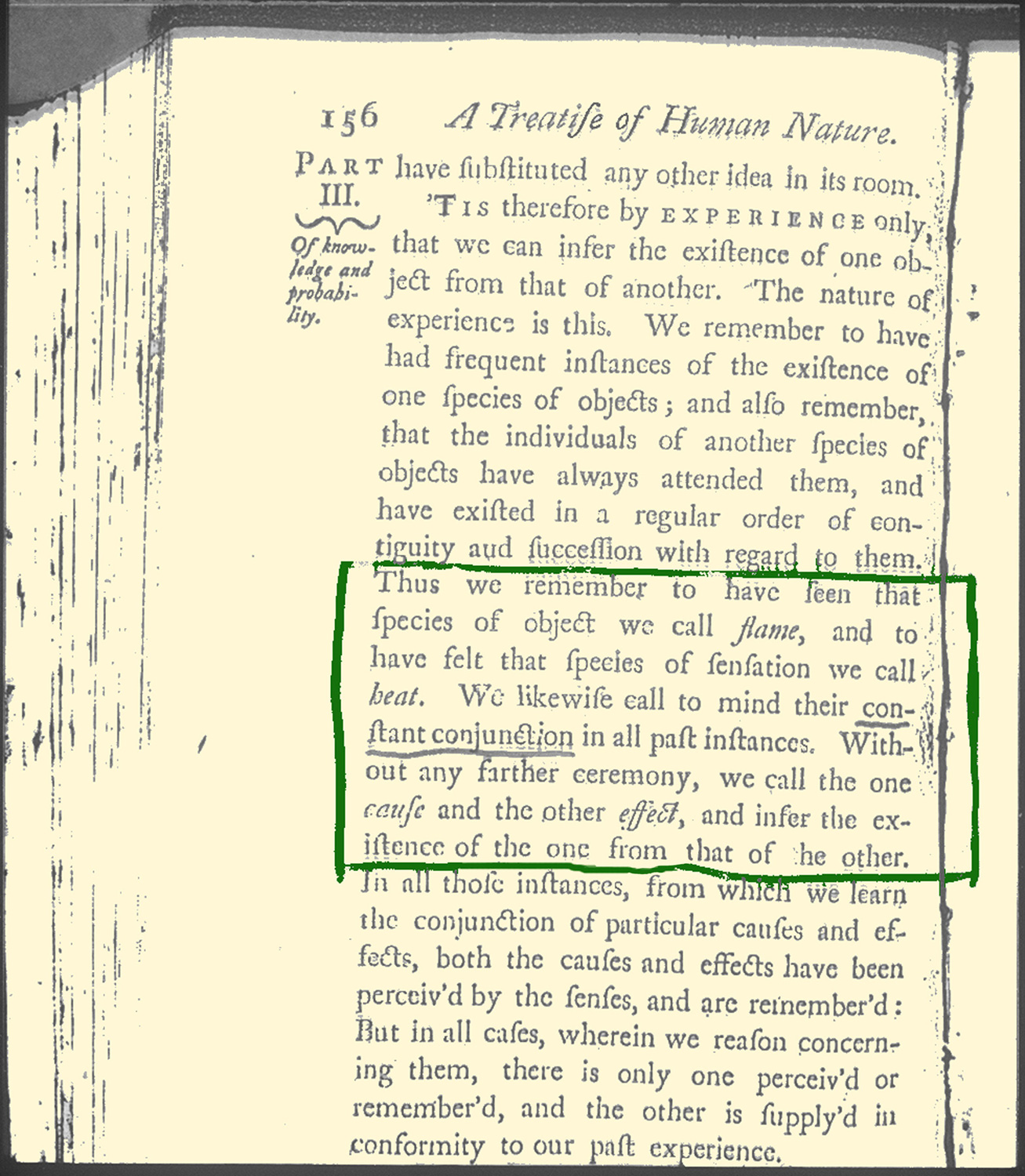
|
SLIDE 23: PAGE 156 FROM "A TREATISE OF HUMAN NATURE"
On page 156 of Hume's "Treatise of Human Nature", we find the
paragraph that shook up causation so thoroughly that it
has not recovered to this day.
I always get a kick reading it:
"Thus we remember to have seen that species
of object we call *FLAME*, and to have felt
that species of sensation we call *HEAT*. We
likewise call to mind their constant conjunction in
all past instances. Without any farther ceremony,
we call the one *CAUSE* and the other *EFFECT*,
and infer the existence of the one from that of the
other."
Thus, causal connections according to Hume are
product of observations. Causation is a learnable
habit of the mind,
almost as fictional as optical illusions and as
transitory as Pavlov's conditioning.
It is hard to believe that Hume was not aware of the
difficulties inherent in his proposed recipe.
He knew quite well
that the rooster crow STANDS in constant conjunction to the
sunrise, yet it does not CAUSE the sun to rise.
He knew that the barometer reading STANDS in constant
conjunction to the rain, but does not CAUSE
the rain.
|
Today these difficulties fall under the rubric of
SPURIOUS CORRELATIONS, namely "correlations that do not imply causation".
Now, taking Hume's dictum that
all knowledge comes from experience, that experience
is encoded in the mind as correlation, and
our observation that correlation does
not imply causation, we are led into
our first riddle of causation:
How do people EVER acquire knowledge of CAUSATION?
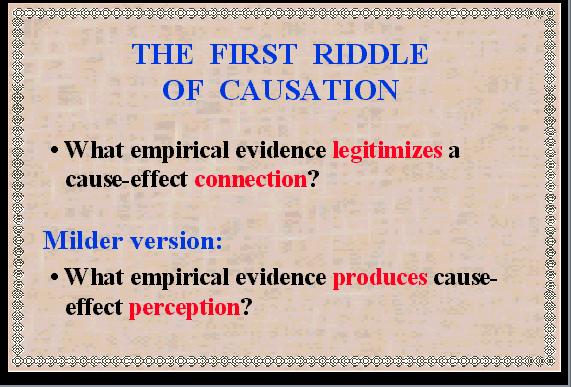
|
SLIDE 24: THE FIRST RIDDLE OF CAUSATION
We saw in the rooster example that regularity of succession
is not sufficient; what WOULD be sufficient?
What patterns of experience would justify calling
a connection "causal"?
Moreover: What patterns of experience
CONVINCES people that a connection is "causal"?
|
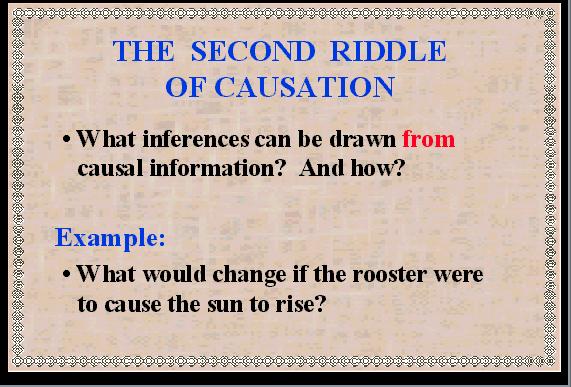
|
SLIDE 25: THE SECOND RIDDLE OF CAUSATION
If the first riddle concerns the LEARNING
of causal-connection, the second
concerns its usage:
What DIFFERENCE does it make if I told you
that a certain connection is or is not causal:?
Continuing our example, what difference does it make
if I told you that the rooster does cause the sun to rise?
This may sound trivial.
The obvious answer is that knowing what causes what
makes a big difference in how we act.
If the rooster's crow
causes the sun to rise we could make the
night shorter by waking up our rooster earlier and make him
crow -- say by telling him the latest rooster joke.
|
But this riddle is NOT as trivial as it seems.
If causal information has an empirical meaning
beyond regularity of succession, then that information
should show up in the laws of physics.
But it does not!
The philosopher Bertrand Russell made this argument in 1913:
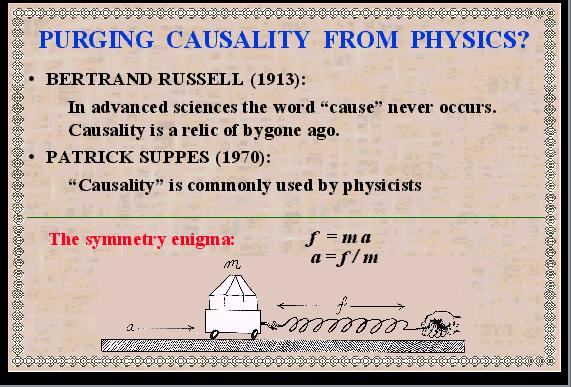
|
SLIDE 26: PURGING CAUSALITY FROM PHYSICS?
"All philosophers, "says Russell," imagine that
causation is one of the fundamental axioms of
science, yet oddly enough, in
advanced sciences, the word 'cause' never occurs ... The law of
causality, I believe,
is a relic of bygone age,
surviving, like the monarchy, only because it is
erroneously supposed to do no harm ..."
Another philosopher, Patrick Suppes, on the other hand,
arguing for the importance of causality, noted that:
"There is scarcely an issue of *PHYSICAL REVIEW*
that does not contain at least one article
using either `cause' or `causality' in its title."
|
What we conclude from this exchange is that
physicists talk, write, and think one way and formulate
physics in another.
Such bi-lingual activity would be forgiven if causality
was used merely as a
convenient communication device --- a shorthand for expressing
complex patterns of physical relationships
that would otherwise take many equations to write.
After all! Science is full of abbreviations:
We use, "multiply x by 5", instead of "add x
to itself 5 times"; we say: "density" instead of
"the ratio of weight to volume".
Why pick on causality?
"Because causality is different," Lord Russell would argue,
"It could not possibly be an abbreviation,
because the laws of physics are all symmetrical, going both ways,
while causal relations are uni-directional, going from cause to effect."
Take for instance Newton's law
f = ma
The rules of algebra permit us to write this law
in a wild variety of syntactic forms, all meaning
the same thing -- that if we know any two of the three quantities,
the third is determined.
Yet, in ordinary discourse
we say that force causes acceleration -- not that
acceleration causes force, and we feel very strongly
about this distinction.
Likewise, we say that the ratio f/a helps us DETERMINE
the mass, not that it CAUSES the mass.
Such distinctions are not supported by the
equations of physics, and this leads us to ask whether
the whole causal vocabulary is purely
metaphysical.
"surviving, like the monarchy...etc."
Fortunately, very few physicists paid attention to Russell's enigma.
They continued to write equations in the office
and talk cause-effect in the CAFETERIA, with
astonishing success, they smashed the atom, invented the transistor,
and the laser.
The same is true for engineering.
But in another arena the tension could not go
unnoticed, because in that arena the demand for
distinguishing causal from other relationships was very
explicit.
This arena is statistics.
The story begins with the discovery of correlation,
about one hundred years ago.
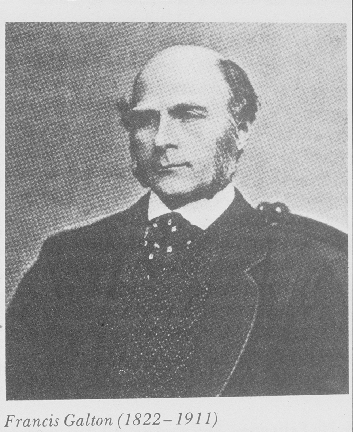
|
SLIDE 27: FRANCIS GALTON (PORTRAIT)
Francis Galton, inventor of fingerprinting and cousin
of Charles Darwin, quite understandably set out to
prove that talent and virtue run in families.
|
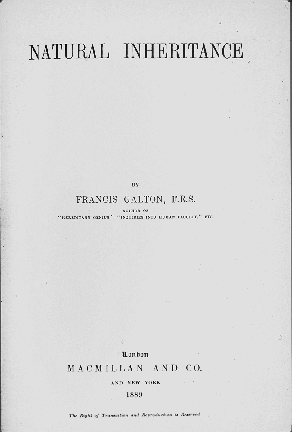
|
SLIDE 28: TITLE PAGE "NATURAL INHERITANCE"
These investigations, drove Galton to consider various ways of
measuring how properties of one class of individuals or objects are
related to those of another class.
|

|
SLIDE 29: GALTON'S PLOT OF CORRELATED DATA (1888)
In 1888, he measured the length of a person's forearm and the
size of that person's head and
asked to what degree
can one of these quantities predict the other.
He stumbled upon the following discovery: If you
plot one quantity against the other
and scale the two axes properly,
then the slope of the best-fit line has some nice mathematical
properties:
The slope is 1 only when one quantity can predict
the other precisely; it is zero whenever the prediction
is no better than a random guess and, most remarkably, the slope
is the same no matter if you plot X against Y or Y against X.
"It is easy to see," said Galton, "that co-
relation must be the consequence of the variations of
the two organs being partly due to common causes."
Here we have, for the first time, an objective measure
of how two variables are "related" to each other, based strictly
on the data, clear of human judgment or opinion.
|
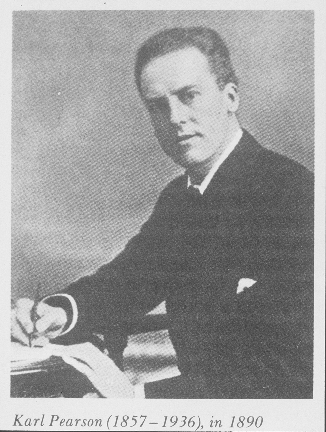
|
SLIDE 30: KARL PEARSON (PORTRAIT, 1890)
Galton's discovery dazzled one of his students, Karl Pearson, now
considered the founder of modern statistics.
Pearson
was 30 years old at the time, an accomplished physicist
and philosopher about to turn lawyer, and this is how he describes,
45 years later, his initial reaction to Galton's discovery:
|
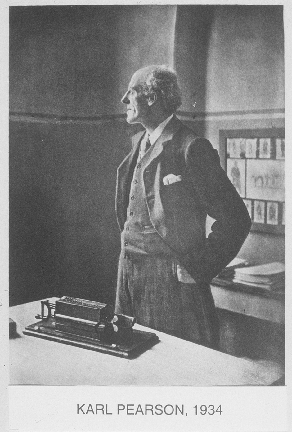
|
SLIDE 31: KARL PEARSON (1934)
"I felt like
a buccaneer of Drake's days --...
I interpreted that
sentence of Galton to mean that there was a category
broader than causation, namely correlation, of which
causation was only the limit, and that this new
conception of correlation brought psychology,
anthropology, medicine, and sociology in large parts
into the field of mathematical treatment."
Now, Pearson has been described as a person "with the kind of drive and
determination that took Hannibal over the Alps and
Marco Polo to China."
When Pearson felt like a buccaneer, you
can be sure he gets his bounty.
|
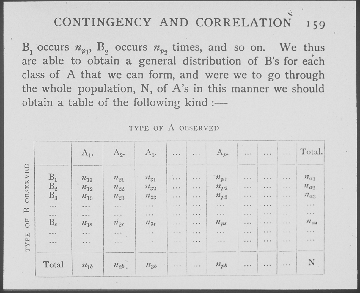
|
SLIDE 32: CONTINGENCY TABLE (1911)
1911 saw the publication of
the third edition of his book "The Grammar of Science".
It contained a new chapter titled
"Contingency and correlation - the insufficiency of
causation," and this is what Pearson says in that chapter:
"Beyond such discarded fundamentals as 'matter' and 'force' lies
still another fetish amidst the inscrutable arcana of modern science,
namely, the category of cause and effect."
|
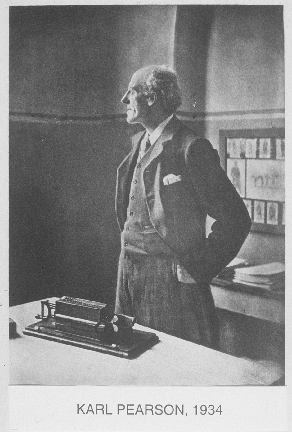
|
SLIDE 33: KARL PEARSON (1934)
Thus, Pearson categorically denies the need for an
independent concept of causal relation beyond
correlation.
He held this view throughout his life and,
accordingly, did not mention causation in
ANY of his technical papers.
His crusade against animistic concepts such as "will" and "force"
was so fierce and his rejection of determinism so absolute that he
EXTERMINATED causation from statistics before it had
a chance to take root.
|
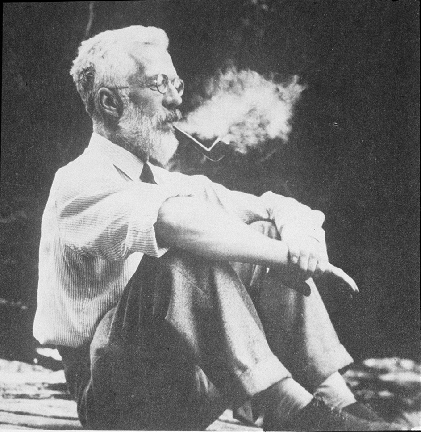
|
SLIDE 34: SIR RONALD FISHER
It took another 25 years and
another strong-willed person, Sir Ronald Fisher, for
statisticians to formulate the randomized experiment -- the
only scientifically proven method of testing causal
relations from data, and which is, to this day, the one and only causal concept
permitted in mainstream statistics.
And that is roughly where things stand today...
If we count the number of doctoral theses, research
papers, or textbooks pages
written on causation, we get the impression that Pearson still
rules statistics.
The "Encyclopedia of Statistical
Science" devotes 12 pages to correlation but only 2
pages to causation, and spends one of those pages
demonstrating that "correlation does not imply
causation."
Let us hear what modern statisticians say about causality
|
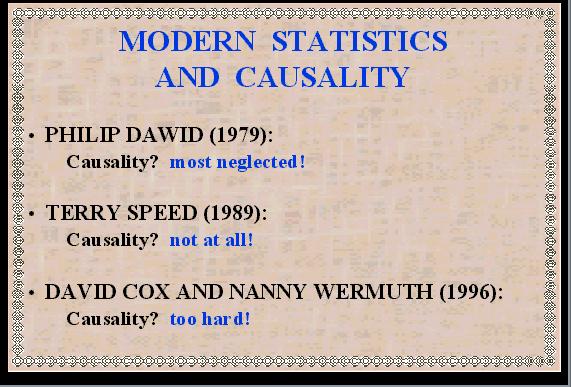
|
SLIDE 35: MODERN STATISTICS AND CAUSALITY
Philip Dawid , the current editor of Biometrika--the
journal founded by Pearson -- admits:
"causal inference is one of the most important, most
subtle, and most neglected of all the problems of
statistics".
Terry Speed, former president of the Biometric Society
(whom you might remember as an expert witness at the
O.J. Simpson murder trial),
declares: "considerations of causality
should be treated as they have always been treated in
statistics: preferably not at all, (but if necessary, then
with very great care.)"
Sir David Cox and Nanny Wermuth,
in a book published just a few months ago, apologize as follows: "We did
not in this book use the words CAUSAL or CAUSALITY....
Our reason for caution is that it is rare that firm
conclusions about causality can be drawn from one
study."
|
This position of caution and avoidance has paralyzed many fields
that look to statistics for guidance, especially economics and social science.
A leading social scientist stated in 1987:
"It would be very healthy if more researchers
abandon thinking of and using terms such as
cause and effect."
Can this state of affairs be the work of just
one person? even a buccaneer like Pearson?
I doubt it.
But how else can we explain why statistics, the field that
has given the world such powerful concepts as
the testing of hypothesis and the design of experiment
would give up so early on causation?
One obvious explanation is, of course,
that causation is much harder to measure than
correlation.
Correlations can be estimated directly
in a single uncontrolled study, while causal conclusions
require controlled experiments.
But this is too simplistic;
statisticians are not easily detrred by difficulties and
children manage to learn cause effect relations
WITHOUT running controlled experiments.
The answer, I believe lies deeper,
and it has to do with the official language
of statistics, namely the language of probability.
This may come as a surprise to some of you but
the word "CAUSE" is not in the vocabulary of probability theory;
we cannot express in the language of probabilities the sentence,
"MUD DOES NOT CAUSE RAIN" -- all we can say is that the two
are mutually correlated, or dependent -- meaning if we find one,
we can expect the other.
Naturally, if we lack a language to express a certain concept
explicitly, we can't expect to develop scientific activity
around that concept.
Scientific development requires that knowledge be transferred
reliably from one study to another and, as Galileo has shown
350 years ago, such transference requires the precision
and computational benefits of a formal language.
I will soon come back to discuss the importance of
language and notation, but first,
I wish to conclude this
historical survey with a tale from another field in
which causation has had its share of difficulty.
This time it is computer science -- the science of
symbols -- a field that is relatively new, yet it has
placed a tremendous emphasis on language and notation and,
therefore, may offer a useful
perspective on the problem.
When researchers began to encode causal
relationships using computers, the two riddles of
causation were awakened with renewed vigor.
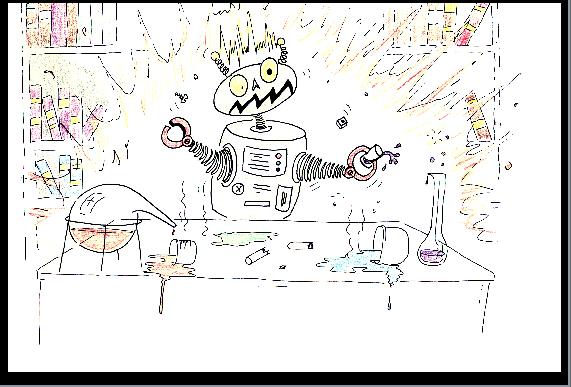
|
SLIDE 36: ROBOT IN LAB
Put yourself in the shoes of this robot who is trying to
make sense of what is going on in a kitchen or a
laboratory.
Conceptually, the robot's problems are the
same as those faced by an economist seeking to model the National debt
or an epidemiologist attempting to
understand the spread of a disease.
Our robot,
economist, and epidemiologist all need to track down
cause-effect relations from the environment, using
limited actions and noisy
observations.
This puts them right at Hume's first
riddle of causation: HOW?
|
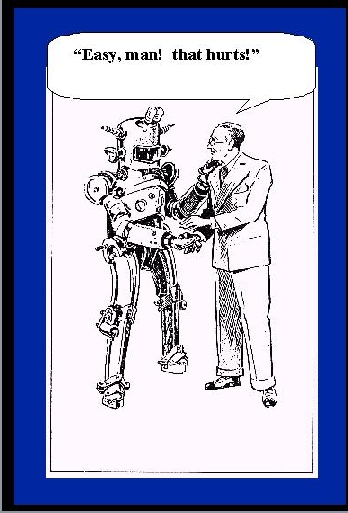
|
SLIDE 37: ROBOT WITH MENTOR
The second riddle of causation also plays a role in the
robot's world.
Assume we wish to take a shortcut and
teach our robot all we know about cause and
effect in this room.
How should the robot organize and
make use of this information?
Thus, the two philosophical riddles of causation are
now translated into concrete and practical questions:
|

|
SLIDE 38: OLD RIDDLES IN NEW DRESS
How should a robot acquire causal information
through interaction with its environment?
How should a robot process causal information
received from its creator-programmer?
Again, the second riddle is not as trivial as it might
seem. Lord Russell's warning that causal relations and
physical equations are incompatible now surfaces as an
apparent flaw in logic.
|
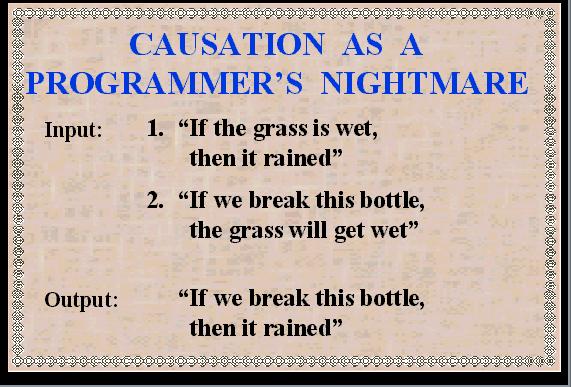
|
SLIDE 39: CAUSALITY: A PROGRAMMER'S NIGHTMARE
For example, when given the information, "If the grass
is wet, then it rained" and "If we
break this bottle, the grass will get wet," the
computer will conclude "If we break this bottle, then
it rained."
The swiftness and specificity with which such programming
bugs surface, have made Artificial-Intelligence programs an ideal laboratory
for studying the fine print of causation.
|
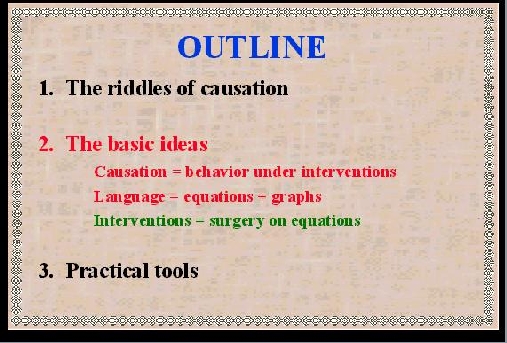
|
SLIDE 40: OUTLINE - PART 2
This brings us to the second part of the lecture: how
the second riddle of causation can be solved by
combining equations with graphs, and how this
solution makes the first riddle less formidable.
The overriding ideas in this solution are:
FIRST: treating causation as a summary of behavior
under interventions and
SECOND: using equations and graphs as a mathematical
language within which causal thoughts can be represented and
manipulated.
And to put the two together, we need a THIRD concept:
Treating interventions a s a surgery over equations.
Let us start with an area that uses causation extensively
and never had any trouble with it: Engineering.
|
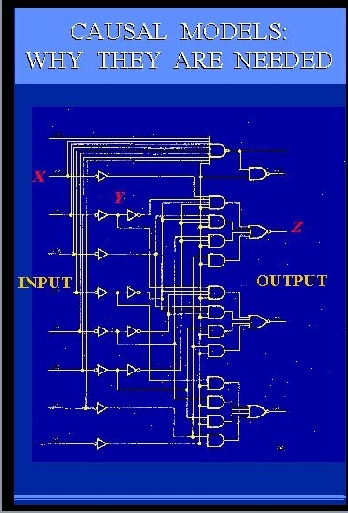
|
SLIDE 41: CIRCUIT DIAGRAM
Here is an engineering drawing of a circuit diagram that
shows cause-effect relations
among the signals in the circuit.
The circuit consists of AND gates and OR gates,
each performing some logical function between
input and output.
Let us examine this diagram closely,
since its simplicity and familiarity are very deceiving.
This diagram is, in fact, one of the greatest marvels of science.
It is capable of conveying more information than
millions of algebraic equations
or probability functions or logical expressions".
What makes this diagram so much more powerful
is the ability to predict
not merely how the circuit behaves
under normal conditions, but also
how the circuit will behave under millions
of ABNORMAL conditions.
For example, given this circuit diagram, we can
easily tell
what the output will be if some input changes from 0 to 1.
This is normal and can easily be expressed by a
simple input-output equation.
Now comes the abnormal part.
We can also tell
what the output will be when we set Y to 0 (zero), or tie it to X, or
change this AND gate
to an OR gate,
or when we perform any of the millions combinations of
these operations.
|
The designer of this circuit did not
anticipate or even consider such weird interventions, yet,
miraculously, we can predict their consequences. How?
Where does this representational power come
from?
It comes from what
early economists called AUTONOMY, namely, the gates
in these diagram represent
independent mechanisms -- it is easy to change one without changing the other.
The diagram takes advantage
of this independence and describes
the normal functioning of the circuit
USING PRECISELY THOSE BUILDING BLOCKS THAT WILL
REMAIN UNALTERED UNDER INTERVENTION.
My colleagues from Boelter Hall are surely wondering why
I stand here before you blathering about an engineering
triviality as if it were the 8th wonder of the world.
I have three reasons for doing this.
First, I will try to show that there is a lot of unexploited
wisdom in practices that engineers take for granted.

|
SLIDE 42: PATH DIAGRAMS
Second, I am trying to remind economists and social scientists
of the benefits of this diagrammatic method.
They have been using a similar method on and off for over 75 years,
called structural equations modeling and path-diagrams, but in recent years
have allowed algebraic convenience to suppress
the diagrammatic representation, together with its benefits.
Finally, these diagrams capture in my opinion, the very
essence of causation -- the ability to predict the consequences of abnormal
eventualities and new manipulations.
In this diagram, for example, it is possible to predict what
coat pattern the litter guinea-pig is likely to have, if we change
environmental factors, shown here by as input (E) in green, or even
genetic factors, shown in red as intermediate nodes between parents
|
and offsprings (H).
Such predictions cannot be made on the basis
of algebraic or correlational analysis.
Viewing causality this way explains
why scientists pursue causal explanations with
such zeal, and
why attaining a causal model is
accompanied with a sense of gaining "deep understanding" and
"being in control."

|
SLIDE 43: DUCK MACHINE
DEEP UNDERSTANDING means
knowing, not merely how things behaved
yesterday, but also how things will behave under new
hypothetical circumstances, control being one such circumstance.
Interestingly, when we have such understanding we feel "in control"
even when if we have no practical way of controlling things.
For example, we have no practical way to control
celestial motion, and still the theory
of gravitation gives us a feeling of understanding
and control, because it provides a blueprint for hypothetical control.
We can predict the effect on
tidal waves of unexpected new events, say, the moon being
hit by a meteor or the gravitational constant suddenly
diminishing by a factor of 2 and, just as important, the
gravitational theory
gives us the assurance that ordinary manipulation
|
of earthly things will NOT control tidal waves.
It is not surprising that causal
models are viewed as the litmus test distinguishing
deliberate reasoning from reactive or instinctive response.
Birds and monkeys may possibly be trained
to perform complex tasks such as fixing a broken wire, but that
requires trial-and-error training.
Deliberate reasoners, on the other hand, can anticipate
the consequences of new manipulations WITHOUT EVER TRYING
those manipulations.

|
SLIDE 44: EQUATIONS VS. DIAGRAMS
Let us magnify a portion of the circuit diagram so that we
can understand
why the diagram can predict outcomes that equations can not.
Let us also switch from logical gates to linear equations
(to make everyone here more comfortable), and assume we
are dealing with a system containing just two components: a multiplier
and an adder.
The MULTIPLIER
takes the input and multiplies it by
a factor of 2; the ADDER takes its input and adds a 1 to it.
The equations describing these two components
are given here on the left.
But are these equations EQUIVALENT to the diagram
on the right?
Obviously not!
If they were, then let us switch the variables
around, and the resulting two
equations should be equivalent to the circuit shown
below.
But these two circuits are different.
|
The top one tells us that if we physically manipulate Y it will
affect Z, while the bottom one shows that manipulating Y will affect X
and will have no effect on Z.
Moreover, performing some additional algebraic operations
on our equations, we can obtain two new equations, shown
at the bottom, which point to no structure AT ALL;
they simply represent two constraints on
three variables, without telling us how they influence
each other.
Let us examine more closely the mental process by which we
determine the effect of physically manipulating Y, say setting Y to 0.

|
SLIDE 45: INTERVENTION AS SURGERY ON MECHANISM
Clearly, when we set Y to 0,
the relation between X and Y is no
longer given by the multiplier -- a new
mechanism now controls Y, in which
X has no say.
In the equational representation, this amounts to
replacing the equation Y=2X by a new equation, Y=0,
and solving a new set of equations, which gives
Z = 1.
If we perform this surgery on the lower pair of equations,
representing to the lower model, we get
of course a different solution. The second equation will
need to be replaced, which will yield X = 0 and leave
Z unconstrained.
We now see how this model of intervention leads to
a formal definition of causation:
"Y is a cause of Z if we can change Z by manipulating Y, namely, if
after surgically removing the equation for Y, the solution for
Z will depend on the new value we
|
substitute for Y".
We also see how vital the diagram is in this
process.
THE DIAGRAM TELLS US WHICH EQUATION
IS TO BE DELETED WHEN WE MANIPULATE Y.
That information is totally washed out when we transform the
equations into algebraically equivalent form, as shown
at the bottom of the screen --
from this pair equations alone, it is impossible to
predict the result of setting Y to 0, because we do not
know what surgery to perform -- there is no
such thing as "the equation for Y".
IN SUMMARY, INTERVENTION AMOUNTS TO A
SURGERY ON EQUATIONS, GUIDED BY A DIAGRAM, AND CAUSATION
MEANS PREDICTING THE CONSEQUENCES OF SUCH A SURGERY.
This is a universal theme that
goes beyond physical systems.
In fact, the idea of modeling interventions by "wiping out" equations
was first proposed by an ECONOMIST,
Herman Wold in 1960, but his teachings have all but disappeared
from the economics literature.
History books attribute this mysterious disappearance
to Wold's personality, but I tend to believe that the
reason goes deeper:
Early econometricians were very careful mathematicians; they
fought hard to keep their
algebra clean and formal, and could not agree to have it
contaminated by gimmicks such as diagrams.
And as we see on the screen
the surgery operation makes no mathematical sense without
the diagram, as it is sensitive to the way we write the equations.
Before expounding on the properties of this new
mathematical operation, let me demonstrate how
useful it is for clarifying concepts in statistics and economics.

|
SLIDE 46: INTERVENTION AS SURGERY - CONTROLLED EXPERIMENTS
Why do we prefer controlled experiment over uncontrolled studies?
Assume we wish to study the effect of some drug
treatment on recovery of patients suffering from a given disorder.
The mechanism governing the behavior of each patient is
similar in structure to the circuit diagram we saw earlier:
Recovery is a function of both the treatment and other
factors, such as socio-economic conditions, life-style,
diet, age etc. only one such factor is shown here.
Under uncontrolled conditions, the choice of treatment is up to the
patients, and may depend on the patients socio-economic
background.
This creates a problem, because we can't tell if changes in
recovery rates are due to treatment or to those background factors.
What we wish to do is compare patients of same backgrounds
and that is precisely what
Fisher's RANDOMIZED EXPERIMENT accomplishes.
How?
|
It actually consists of two parts, randomization
and INTERVENTION.
Intervention means that we change the natural behavior
of the individual: we separate subjects into two groups,
called treatment and control, and we convince the subjects to
obey the experimental policy.
We assign treatment to some patients who, under normal
circumstances, will not seek treatment, and we give placebo to patients
who otherwise would receive treatment.
That, in our new vocabulary, means SURGERY -- we
are severing one functional link and replacing it by another.
Fisher's great insight was that connecting
the new link to a random coin flip, GUARANTEES
that the link we wish to break, is actually broken.
The reason is, that a random
coin is assumed unaffected by anything we can
measure on a macroscopic level, including, of course,
a patient socio-economic background.
This picture provides a meaningful and formal
rationale for the universally accepted procedure of
radomized trials.
In contrast, our next example uses the
surgery idea to point out inadequacies in widely
accepted procedures.

|
SLIDE 47: EXAMPLE 2 - POLICY ANALYSIS
The example involves a Government official trying to evaluate the
economic consequences of some policy, say taxation.
A deliberate decision to raise or lower taxes is a surgery on the
model of the economy because it modifies the conditions prevailing while the
model was built.
Economic models are built on the basis of data taken over
some period of time, and during this period of time, taxes were lowered and
raised in response to some economic conditions or political pressure.
However, when we EVALUATE
a policy, we wish to compare alternative policies
under the SAME economic conditions, namely we wish
to sever this link that, in the past, has tied policies
to those conditions.
|
In this set-up, it is impossible of course to
connect our policy to a coin and run a controlled
experiment; we do not have the time
for that, and we might ruin the economy before the
experiment is over.
Nevertheless the analysis that
we SHOULD CONDUCT is to infer the behavior of this
mutilated model from data governed by a non-mutilated
model.
I said, SHOULD CONDUCT, because you will not find such analysis in
any economics textbook.
As I mentioned earlier, the surgery idea of
Herman Wold,
was stamped out of the economics literature in the 1970's
and all discussions on policy analysis that I could find, assume that the
mutilated model prevails throughout.
The fact that taxation is under government
control at the time of evaluation is assumed to be
sufficient for treating taxation an exogenous variable
throughout when, in fact, taxation is an engodenous variable
during the model-building phase, and turns exogenous
only when evaluated.
Of course, I am not claiming that reinstating the surgery model
would enable the government to balance its budget overnight,
but it is certainly something worth trying.
Let us examine now how the surgery interpretation resolves Russell's
enigma: concerning the clash between the directionality of
causal relations and the symmetry of physical equations.
The equations of physics are indeed symmetrical,
but when we compare the phrases "A CAUSES B"
vs. "B CAUSES A" we are not talking about a single
set of equations.
Rather, we are comparing two
world models, represented by two different sets of equations;
one in which the equation for A is surgically removed,
the other where the equation for B is removed.
Russell would probably stop us at this point and ask:
"How can you talk about TWO world models,
when in fact there is only one world model, given by all the equations
of physics put together?"
The answer is: YES.
If you wish to include the entire universe in the model,
causality disappears because interventions disappear -- the manipulator and the
manipulated loose their distribution.
However, scientists rarely
consider the entirety of the universe as an object of
investigation.
In most cases the scientist carves a
piece from the universe and proclaims that piece: IN namely, the FOCUS
of investigation.
The rest of the universe is then
considered OUT or BACKGROUND, and is summarized by
what we call BOUNDARY Conditions
THIS CHOICE OF inS AND outS CREATES ASYMMETRY IN THE WAY WE
LOOK AT THINGS, AND IT IS THIS ASYMMETRY THAT PERMITS US TO TALK ABOUT
"OUTSIDE INTERVENTION", HENCE, CAUSALITY AND CAUSE-EFFECT DIRECTIONALITY.

|
SLIDE 48: HAND-EYE SYSTEM (DESCARTES, L'HOMME)
This can be illustrated quite nicely using Descartes
classical drawing.
As a whole, this hand-eye system knows nothing about
causation.
It is merely
a messy plasma of particles and photons trying their very
best to obey Schroedinger's Equation, which is symmetric.
|

|
SLIDE 49: HAND-EYE SECTION
However, carve a chunk from it, say the
object part, and we can talk about the motion of
the hand CAUSING this light ray to change angle.
|
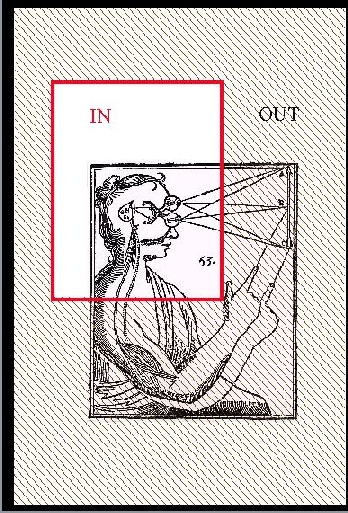
|
SLIDE 50: EYE-HAND SECTION
Carve it another way, focusing on the
brain part, and, lo and behold, it is now
the light ray that causes the hand to move --
-- precisely the opposite direction.
The lesson is that it is the way we carve up the
universe that determines the directionality
we associate with cause and effect.
Such carving is tacitly assumed in every scientific investigation.
In artificial intelligence it was called circumscription,
by J. McCarthy.
In economics, circumscription amount to deciding which variables
are deemed endogenous and which ones exogenous, IN the
model or EXTERNAL to the model.
|

|
SLIDE 51: FROM PHYSICS TO CAUSALITY
Let us summarize the essential differences
between equational and causal models.
Both use a set of symmetric equations to describe
normal conditions.
The causal model, however,
contains three additional ingredients:
a distinction between the IN and the OUT.
An assumption that each equation corresponds to
an independent mechanism, hence, it must be preserved as a separate mathematical sentence.
Interventions are interpreted as surgeries
over those mechanism.
This brings us closer to realizing the dream of
making causality a friendly part of physics.
But one ingredient is missing: THE ALGEBRA.
We discussed earlier how important the computational
facility of algebra was to scientists and engineers in
the Galilean era.
Can we expect such algebraic facility to serve causality as well?
Let me rephrase it differently:
Scientific activity, as we know it, consists
of two basic components:
|
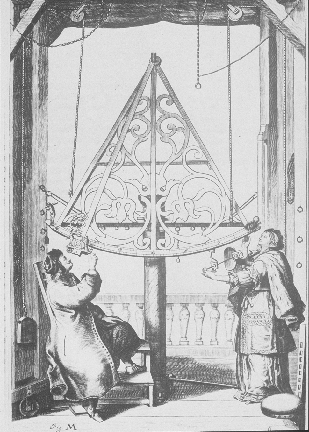
|
SLIDE 52: OBSERVATORY (HEVELIUS, 1673)
Observations
|
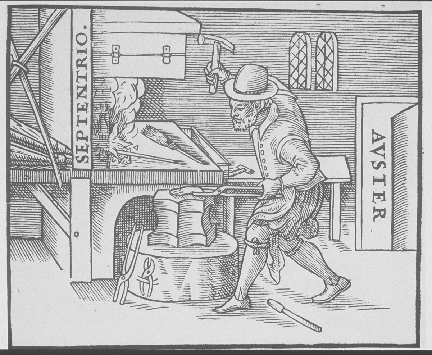
|
SLIDE 53: HAMMERING A MAGNET (GILBERT, DE MAGNET, 1600)
and interventions.
The combination of the two is what we call
a LABORATORY,
|
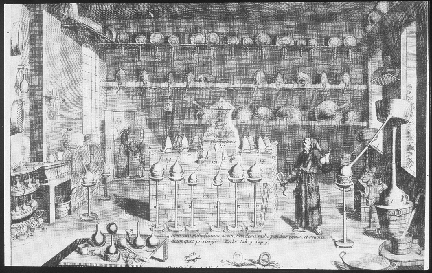
|
SLIDE 54: LABORATORY
a place where we control
some of the conditions and observe others.
It so happened that standard algebras
have served the observational component very well,
but, thus far, have not benefited the interventional component.
This is true for the algebra of equations,
Boolean algebra, and probability calculus,
all are geared to serve observational sentences,
but not interventional sentences.
|
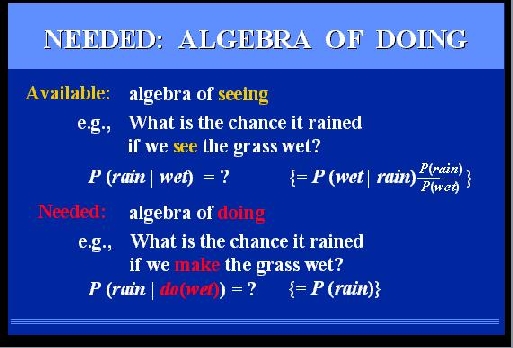
|
SLIDE 55: NEEDED: ALGEBRA OF DOING (CONT.)
Take for example, probability theory.
If we wish to find the chance it rained, given that we
see the grass wet, we can express our question
in a formal sentence written like that:
P(rain|wet)
to be read: Probability~Of~Rain~given~~Wet
The vertical bar stands for the phrase: "given that we see"
Not only can we express this question
in a formal sentence but we can also use the machinery of probability
theory and transform the
sentence into other expressions.
In our example, the sentence on the left can be transformed to
the one on the right, if we find it more convenient or informative.
But suppose we ask a different question:
"What is the chance it rained if we MAKE the grass wet?"
We cannot even express our query in the syntax of probability, because the vertical bar is already taken to mean "given that I see".
We can invent a new symbol
|
"DO", and each time we see a DO
after the bar we read it "GIVEN THAT WE DO" -- but this does not help
us compute the answer to our question, because the rules of probability
do not apply to this new reading.
We know intuitively what the answer should be:
P(rain), because making the grass wetdoes not change the chance of rain.
But can this intuitive answer, and others like
it, be derived mechanically?
so as to comfort our thoughts when intuition fails?
The answer is YES, and it takes a new algebra:
First, we assign a symbol to the new operator
"given that I do".
Second, we find
the rules for manipulating sentences containing
this new symbol.
We do that by a process analogous to
the way mathematicians found the rules of
standard algebra.
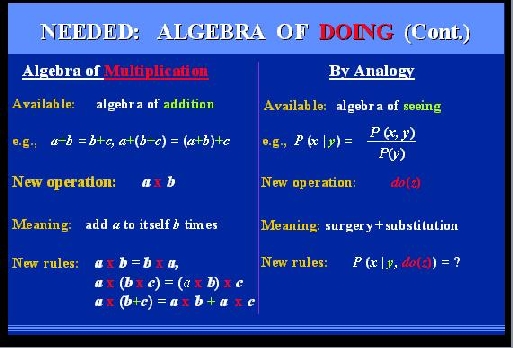
|
SLIDE 56: NEEDED: ALGEBRA OF DOING
Imagine that you are a mathematician in the 16th
century, you are now an expert in the algebra
of ADDITION, and you feel an urgent need to introduce
a new operator: MULTIPLICATION, because you are tired of
adding a number to itself all day long.
First thing you do is assign the new operator a symbol:
MULTIPLY.
Then you go down to the meaning of the operator,
from which you can deduce its rules of transformations.
For example: the commutative law of multiplication
can be deduced that way, the associative law,
and so on,.... we now learn all this in high school.
In exactly the same fashion, we can deduce the rules
that govern our new symbol: do(x).
We have an algebra for seeing, namely, probability theory.
We have a new operator, with a brand new red outfit and a
very clear meaning, given to us by the surgery procedure.
The door is open for deduction and the
result is give in the next slide.
|
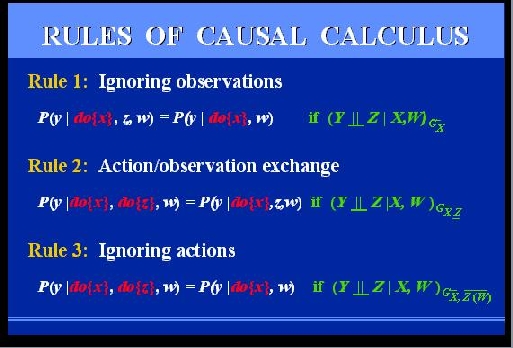
|
SLIDE 57: CAUSAL CALCULUS
Please do not get alarmed, I do not expect you to
read these equations right now, but I think you can still get the
flavor of this new calculus.
It consist of 3 rules that permit
us to transform expressions involving actions
and observations, into other expressions of this type.
The first allows us to ignore an irrelevant observation, the third
to ignore an irrelevant action,
the second allows us to exchange an action with an
observation of the same fact.
What are those green symbols on the right?
These are the green lights which the diagram gives us,
whenever the transformation is legal.
We will see them in action on our next example.
|

|
SLIDE 58: OUTLINE
Things brings us to part-3 of the lecture,
where I will demonstrate how the ideas presented
thus far can be used to solve new problems of
practical importance.
|

|
SLIDE 59: DOES SMOKING CAUSE CANCER
Consider the century old debate concerning the
effect of smoking on lung cancer.
In 1964, the Surgeon General issued a report linking
cigarette smoking to death, cancer and most particularly,
lung cancer.
The report was based on non-experimental studies, in which
a strong correlation was found between smoking and lung
cancer, and the claim was that the correlation found is
causal, namely:
If we ban smoking, the rate of
cancer cases will be roughly the same
as the one we find today among non-smokers in the population.
These studies came under severe attacks from
the tobacco industry, backed by some very prominent statisticians,
among them Sir Ronald Fisher.
The claim was that the observed correlations can
also be explained by a model in which there is no causal connection
between smoking and lung cancer.
Instead, an unobserved
genotype might exist which simultaneously
|
causes cancer and
produces an inborn craving for nicotine.
Formally, this claim would be written in our notation
as: P(cancer | do(smoke)) = P(cancer)
stating that making the population smoke or stop smoking
would have no effect on the rate of cancer cases.
Controlled experiment could decide between the two models, but
these are impossible, and now also illegal to conduct.
This is all history.
Now we enter a hypothetical
era where representatives of both sides decide
to meet and iron out their differences.
The tobacco industry concedes that there might
be some weak causal link between smoking and
cancer and representatives of the health group
concede that there might be some weak links to
genetic factors.
Accordingly, they draw this combined model,
and the question boils down to assessing,
from the data, the strengths of the various links.
They submit the query to a statistician and the answer
comes back immediately: IMPOSSIBLE.
Meaning: there is
no way to estimate the strength from the data, because
any data whatsoever can perfectly fit either
one of these two extreme models.
So they give up, and decide to continue the political
battle as usual.
Before parting, a suggestion comes up:
perhaps we can resolve our differences,
if we measure some auxiliary factors,
For example, since the causal link model
is based on the understanding that smoking affects
lung cancer through the accumulation of tar deposits
in the lungs, perhaps we can measure the amount of
tar deposits in the lungs of sampled individuals, and this might provide
the necessary information for quantifying the links?
Both sides agree that this is a reasonable suggestion,
so they submit a new query to the statistician: Can we
find the effect of smoking on cancer assuming that an
intermediate measurement of tar deposits is available???
The statistician comes back with good news: IT IS COMPUTABLE and,
moreover, the solution is given in close mathematical form. HOW?

|
SLIDE 60: TYPICAL DERIVATION IN CAUSAL CALCULUS
The statistician recevies the problem, and treats it as
a problem in High School ALGEBRA: We need to compute P(cancer) under
hypothetical action, from non-experimental data, namely,
from expressions involving NO ACTIONS. Or: we need to
eliminate the "do" symbol from the initial expression.
The elimination proceeds like ordinary solution of algebraic
equation -- in each stage, a new rule is applied, liscenced by some subgraph
of the diagram, until eventually leading to a formula involving only
WHITE SYMBOLS, meaning expression computable from non-experimental data.
You are probably wondering whether this derivation
solves the smoking-cancer debate. The answer is NO.
Even if we could get the data on tar deposits, the
model above is
|
quite simplistic, as it is based on certain
assumptions which both parties might not agree to.
For instance,
that there is no direct link between smoking and lung cancer,
immediated by tar deposits.
The model would need to be refined then, and we might
end up with a graph containing 20 variables or more.
There is no need to
panic when someone tells
us: "you did not take this or that factor into account".
On the contrary, the graph welcomes such new
ideas, because it is so easy to add factors and measurements
into the model.
Simple tests are now available that permit an investigator to merely
glance at the graph and decide if we can compute the effect of one variable
on another.
Our next example illustrates how a long-standing problem is solved
by purely graphical means -- proven by the new algebra.
The problem is called THE ADJUSTMENT PROBLEM or "the covariate selection
problem" and represents the practical side of Simpson's paradox.

|
SLIDE 61: SIMPSON'S PARADOX
Simpson's paradox, first noticed by Karl Pearson in 1899, concerns
the disturbing observation that every statistical relationship between
two variables may be REVERSED by including additional factors
in the analysis.
For example, you might run a study and find that students who smoke
get higher grades, however, if you adjust for AGE, the opposite is true in every AGE GROUP, namely, smoking predicts lower grades.
If you further adjust for PARENT INCOME, you find that smoking predicts
higher grades again, en every AGE-INCOME group, and so on.
Equally disturbing is the fact that no one has been able to tell
us which factors SHOULD be included in the analysis.
Such factors can now be identified by simple graphical means.
|
The classical case demonstrating Simpson's paradox
took place in 1975, when UC Berkeley was investigated for
sex bias in graduate admission.
In this study,
overall data showed a higher rate of admission among male
applicants, but, broken down by departments, data showed a
slight bias in favor of admitting female applicants.
The explanation is simple: female applicants tended
to apply to more competitive departments than males,
and in these departments, the rate of admission was low for
both males and females.

|
SLIDE 62: FISHNET
To illustrate this point, imagine a fishing boat with two
different nets, a large mesh and a small net. A school of fish swim towards
the boat and seek to pass it.
The female fish try for the small-mesh challenge, while the male
fish try for the easy route. The males go through and only females are caught.
Judging by the final catch, preference toward female is clearly
evident. However, if analyzed separately, each individual net would
surely trap males more easily than females.
Another example involves a controversy
called "reverse regression", which occupied the social
science literature in the 1970's.
Should we, in salary discrimination
cases, compare salaries of equally qualified men and women,
or, instead, compare qualifications of equally paid men
and women?
Remarkably, the two choices led to
|
opposite conclusions.
It turned out that men earned
a higher salary than equally qualified women,
and SIMULTANEOUSLY, men were more qualified than
equally paid women.
The moral is that all conclusions are extremely
sensitive to which variables we choose to hold constant
when we are comparing, and that is why the adjustment problem
is so critical in the analysis of observational studies.

|
SLIDE 63: THE STATISTICAL ADJUSTMENT PROBLEM
Consider an observational study where we wish to
find the effect of X on Y, for example, treatment on
response.
We can think of many factors that are relevant to the problem;
some are affected by the treatment, some
are affecting the treatment and some are affecting
both treatment and response.
Some of these factors may be unmeasurable, such
as genetic trait or life style, others are measurable,
such as gender, age, and salary level.
Our problem is to select a subset of these factors
for measurement and adjustment, namely, that if we compare subjects
under the same value of those measurements and average, we get the
right result.
|

|
SLIDE 64: GRAPHICAL SOLUTION OF THE ADJUSTMENT PROBLEM
Let us follow together the steps that would be required to
test if two candidate measurements, Z1 and Z2, would be
sufficient.
The steps are rather simple, and can be performed manually, even on
large graphs.
However, to give you the feel of their mechanizability, I
will go through them rather quickly.
Here we go.
|
SLIDES 65-69: GRAPHICAL SOLUTION OF THE ADJUSTMENT PROBLEM (CONT)
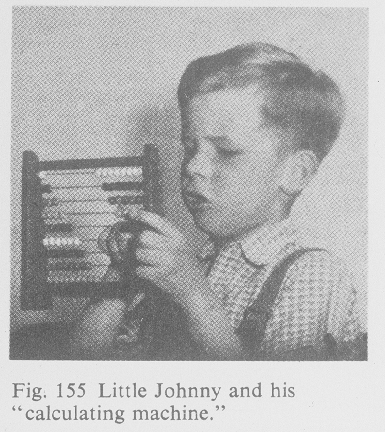
|
SLIDE 70: ABACUS
What I have presented to you today is a sort of pocket
calculator, an ABACUS, to help us investigate certain
problems of cause and effect with mathematical precision.
This does not solve all the problems of causality, but
the power of SYMBOLS and mathematics
should not be underestimated.
|
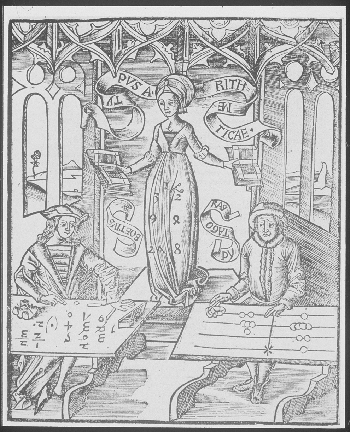
|
SLIDE 71: A CONTEST BETWEN THE OLD AND THE NEW ARITHMETIC
Many scientific discoveries have been
delayed over the centuries for the lack
of a mathematical language that can amplify ideas and
let scientists communicate results.
And I am convinced that many discoveries have been delayed
in our century for lack of a mathematical language that can
handle causation.
For example, I am sure that Karl Pearson could have thought up the
idea of RANDOMIZED EXPERIMENT in 1901,
if he had allowed causal diagrams into his mathematics.
But the really challenging problems are still ahead:
We still do not have a causal understanding of POVERTY and
CANCER and INTOLERANCE,
and only the accumulation of data and the insight of
great minds will eventually lead to such understanding.
The data is all over the place, the insight is yours,
and now an abacus is at your disposal too.
I hope the combination amplifies each of these components.
Thank you.
|
|








































































